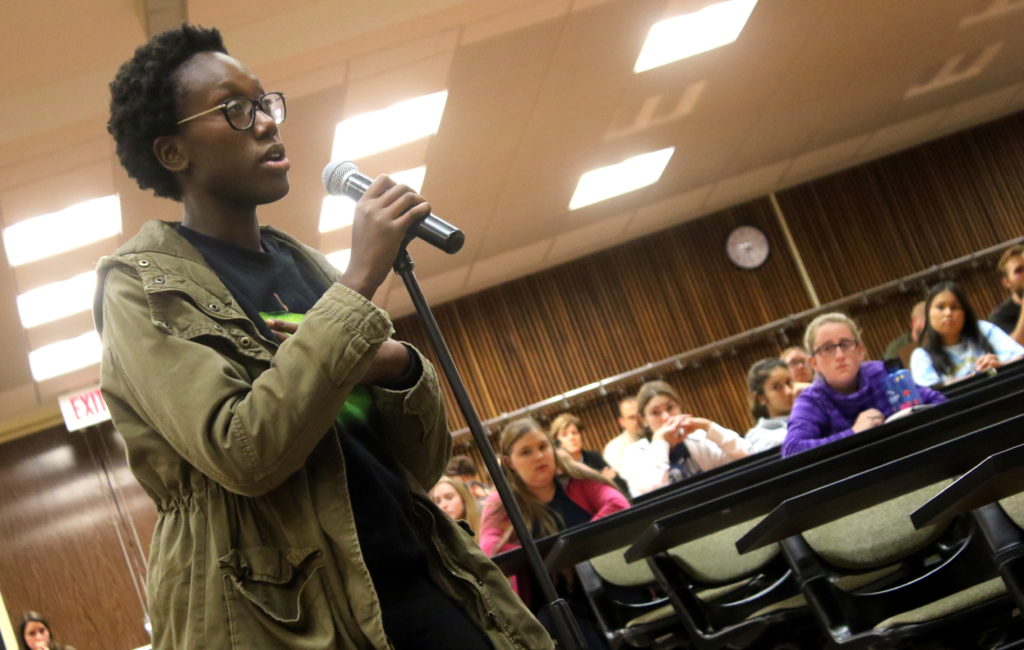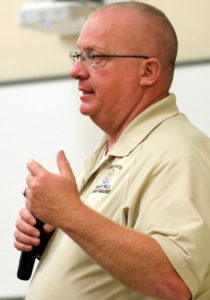Emergency Alerts, Active Shooter Drills Pledged
At SUNY Public Forum,
Students Ask For Empathy

By JENNIFER HILL • Special To www.AllOTSEGO.com

ONEONTA – Sarina Hall, a SUNY Oneonta freshman, knew exactly what to do when the “shelter in place” order was sent out by the school.
She and her fellow students in 102 Schumacher Hall stacked 40 desks “up to the ceiling” against the door and shut off the lights. Ten to 15 minutes later, four policemen pushed through the door, yelling and sending the desks crashing to the floor.
“They didn’t identify themselves,” she said, her voice shaking. “I didn’t know if the shooter was coming in at that moment.”
For more than three hours this evening, top administrators, including SUNY President Barbara Jean Morris, Emergency Manager Dave Lincoln and University Police Chief Jennifer Fila, answered students’ questions, attempted to allay concerns and accepted responsibility for at-times confusing communication during what Hal Legg, chief communications & marketing officer, called a “dynamic, rapidly moving situation.”
Before taking questions, Franklin Chambers, vice president/ student development, updated attendees on the events of Oct. 2.
“We first had a cyber-threat, which we deemed credible, and we sent an alert out about that,” Chambers said. “We had just determined that threat was over when we received a second threat through 911 operators that shots had been heard at Schumacher Hall.”
Police and administrators deemed the second threat credible and sent out an emergency alert by text, email and phone call and ordered everyone on campus to shelter in place.
Neither threat was determined to be an active shooter situation, and the investigation revealed that the initial threat came from a student’s hacked phone. Though investigators did not determine what made the gunshot noise in Schumacher Hall was, it was not a gunshot and at no point was anyone on campus found to be in possession of a weapon, according to Lincoln.
“The sound people heard could have been a door slamming or a desk being pushed up against a door,” he said. “In that situation, where people were scared, that sound could have been misconstrued as a gunshot.”
But unlike Hall, not everyone knew what the term “shelter in place” meant, causing more confusion when the alert came in.
“I was walking outside when the alerts went out.”, said Jazmin Phipps. “And I didn’t know what I needed to do for or where I should go.”
She started running and got to a building that was locked on one side. “Fortunately, my student ID worked on the other side.” She added, “We all grew up on doing ‘lock-downs,’ so I think that’s the term that should be used.”
Others said not all faculty seemed to know what to do or showed empathy in the next days for students who felt too upset to return to campus on Thursday.
“A lot of people didn’t show up for class,” said Amarii Smith. “I don’t think there was the appropriate acknowledgement of the trauma students went through, by having class the next day,”
Morris defended her decision to hold classes.
“I didn’t want students to be in isolation and reliving the trauma by themselves,” she said. They have to have the community and routine, which is part of the practices we have in place.”
Another problem, students said, was parents of students who also received the threat alerts and flooded both university and city police with calls, overwhelming their lines.
One student, Troy Morrissey, suggested the campus use “talk-to-text” messages that updated people on the emergency situation’s status when they call police but can’t get through because the police are fielding a flood of calls.
Students and facilities staff also discussed problems with many of the classroom doors’ locks, not all of which worked or were easy to work.
“We are accelerating our lock up program, to upgrade the locks around campus,” Chambers said.
Other measures SUNY will take in the coming months are getting rid of the “all-clear” alert system, which made students panic that there was another threat, as well as adding signage with and instructions on where and how to safely hide if a shelter in place order is sent out.
“I am also available to anyone who wants to talk,” said Chambers.

